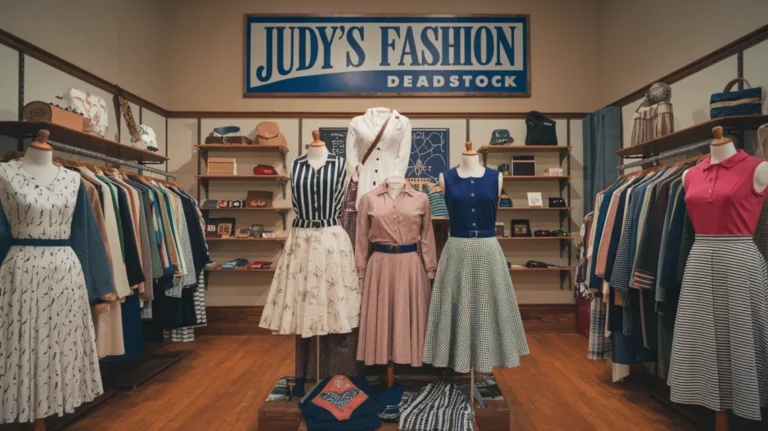
In recent years, sustainable fashion has become a significant topic of discussion among environmentally-conscious consumers and businesses alike. Among the brands contributing to this movement is Judy’s Fashion, a company known for its unique approach to utilizing deadstock materials. But what exactly is deadstock, and how is Judy’s Fashion playing a role in revolutionizing this aspect of the industry? Let’s delve into the details.
What is Deadstock in the Fashion Industry?
Deadstock refers to unsold and unused fabric or clothing that often lies dormant in warehouses, sometimes for years. Historically, these materials were discarded or destroyed, contributing to the massive waste generated by the fashion industry. However, in recent years, deadstock has been repurposed into stylish, eco-friendly garments, giving them a second life.
Key Benefits of Using Deadstock Materials
- Environmental Conservation: Reduces textile waste and prevents fabrics from ending up in landfills.
- Cost-Effectiveness: Offers high-quality materials at a fraction of the original cost.
- Unique Designs: Ensures limited-edition clothing due to the scarcity of materials.
Judy’s Fashion and Its Commitment to Sustainability
Judy’s Fashion has positioned itself as a pioneer in ethical fashion, leveraging deadstock fabrics to craft unique and stylish apparel. By focusing on sustainability, the brand appeals to a growing demographic of consumers who value environmentally responsible choices.
Innovative Practices at Judy’s Fashion
- Careful Sourcing: The brand meticulously selects deadstock fabrics from suppliers around the globe to ensure quality and uniqueness.
- Creative Design: Designers at Judy’s Fashion transform these materials into trendy, modern outfits that resonate with their audience.
- Transparency: They maintain a transparent supply chain, allowing consumers to understand the impact of their purchase.
Is Judy’s Fashion Deadstock Really Sustainable?
While many brands claim to be sustainable, Judy’s Fashion takes its commitment seriously. Here’s why their practices stand out:
Minimal Waste Production
By utilizing deadstock, the company ensures that no fabric goes to waste. Every piece of material is creatively repurposed, minimizing the environmental footprint.
Energy-Efficient Processes
The brand incorporates energy-saving methods in its manufacturing processes, further reducing its environmental impact.
Empowering Local Artisans
Judy’s Fashion collaborates with artisans and small-scale manufacturers, supporting communities and promoting ethical labor practices.
How Deadstock Fashion Impacts the Industry
The use of deadstock materials is not just a trend; it represents a shift toward a circular economy in fashion. This model focuses on reusing and recycling resources to create a sustainable loop.
Changing Consumer Behavior
Consumers are increasingly looking for brands that align with their values. By prioritizing sustainability, companies like Judy’s Fashion cater to this demand and build lasting relationships with their audience.
Driving Industry-Wide Change
Brands adopting deadstock practices push the entire industry toward more sustainable methods, reducing its overall environmental burden.
Challenges in Deadstock Fashion
Despite its benefits, using deadstock comes with its challenges:
- Limited Availability: Deadstock fabrics are often available in small quantities, making large-scale production difficult.
- Quality Control: Ensuring the quality of old or unused fabrics requires additional resources.
- Design Limitations: Designers must work within the constraints of the available material, which can limit creativity.
Judy’s Fashion, however, has embraced these challenges as opportunities to innovate and deliver unique, high-quality products.
Why Choose Judy’s Fashion?
If you’re considering switching to a more sustainable wardrobe, Judy’s Fashion offers several advantages:
- Eco-Friendly Choices: By choosing their products, you actively participate in reducing textile waste.
- Exclusive Designs: Every piece is crafted with limited-edition materials, ensuring your wardrobe stands out.
- Support for Ethical Practices: Your purchase contributes to a transparent and fair supply chain.
How to Incorporate Deadstock Fashion into Your Wardrobe
Embracing deadstock fashion doesn’t have to be daunting. Here are some tips:
- Start Small: Begin with a few key pieces, such as a jacket or a pair of pants, to complement your existing wardrobe.
- Look for Versatility: Choose items that can be styled in multiple ways.
- Prioritize Quality Over Quantity: Invest in well-made pieces that will last for years.
The Future of Deadstock and Sustainable Fashion
The deadstock movement, championed by brands like Judy’s Fashion, is more than a fleeting trend—it’s a glimpse into the future of fashion. As consumers demand more accountability and sustainability, the industry is likely to see even greater innovation in utilizing unused resources.
In conclusion, Judy’s Fashion has carved a niche for itself by turning deadstock fabrics into desirable, sustainable clothing. Their commitment to eco-friendly practices, ethical labor, and unique designs makes them a standout brand in the sustainable fashion landscape. By supporting such initiatives, we can all contribute to a greener, more sustainable future.
Conclusion
Judy’s Fashion is not just about deadstock; it represents a bold movement toward sustainability in the fashion industry. By transforming unused fabrics into stylish and high-quality garments, the brand has successfully turned what was once considered waste into a valuable resource. This innovative approach reduces environmental impact, promotes ethical practices, and sets a benchmark for other fashion brands to follow.
So, is Judy’s Fashion deadstock? Technically, no—it’s a thriving example of how deadstock can be repurposed to redefine modern fashion. With their commitment to sustainability, transparency, and creativity, Judy’s Fashion is proving that eco-friendly fashion can be both practical and luxurious. Supporting such initiatives means embracing a future where style and sustainability coexist seamlessly.